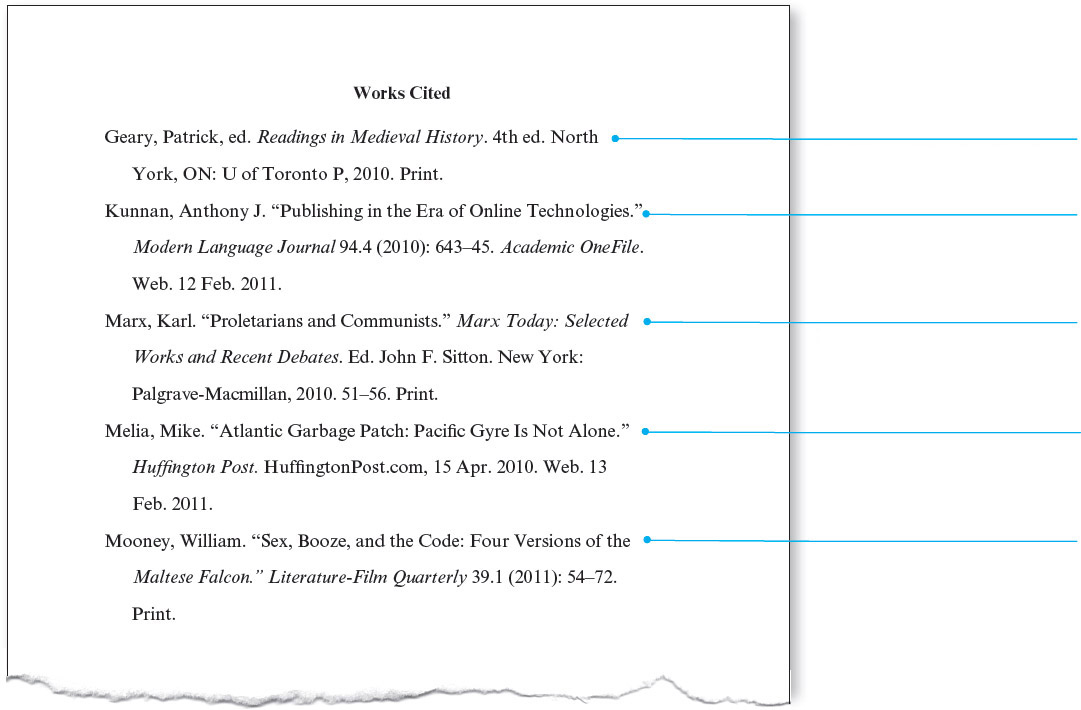MLA Style
Printed Page 641-537
MLA Style
MLA (Modern Language Association) style consists of two elements: citations in the text and a list of works cited at the end of the document.
In MLA style, the textual citation typically includes the name of the source’s author and the number of the page being referred to. Textual citations vary depending on the type of source cited and the context of the citation. The following models illustrate a variety of common situations; for additional examples, consult the MLA Handbook for Writers of Research Papers.
1. Entire Work If you are referring to the whole source, not to a particular page or pages, use only the author’s name.
Harwood’s work gives us a careful framework for understanding the aging process and how it affects communication.
2. Specific Page(s) Immediately following the material you are quoting or paraphrasing, include a parenthetical reference with the author’s name and the page number(s) being referred to. Do not add a comma between the name and the page number, and do not use the abbreviation p. or pp.
Each feature evolves independently, so there can’t be a steady progression of fossils representing change (Prothero 27).
If your sentence already includes the author’s name, put only the page number in the parenthetical citation.
Prothero explains why we won’t find a steady progression of human fossils approaching modern humans, as each feature evolves independently (27).
3. Work Without Page Numbers Give a paragraph, section, or screen number, if provided. Use par. (singular) or pars. (plural) to indicate paragraph numbers. Either spell out or use standard abbreviations (such as col., fig., pt., ch., or l.) for other identifying words. Use a comma after the author’s name if it appears in the parenthetical citation.
Under the right conditions, humanitarian aid forestalls health epidemics in the aftermath of natural disasters (Bourmah, pars. 3–6).
Maternal leave of at least three months has a significantly positive effect on the development of attachment in the infant (Ling, screen 2).
4. Multiple Sources by the Same Author If you cite two or more sources by the same author, either include the full source title in the text or add a shortened title after the author’s name in the parenthetical citation to prevent confusion.
Chatterjee believes that diversification in investments can take many forms (Diversification 13).
Risk is a necessary component of a successful investment strategy (Chatterjee, Failsafe 25).
5. Source with Multiple Authors For a source written by two or three authors, cite all the names.
Grendel and Chang assert that . . .
This phenomenon was verified in the late 1970s (Grendel and Chang 281).
For a source written by four or more authors, either list all the authors or give only the first author, followed by the abbreviation et al. Follow the same format as in the works-cited list.
Studies show that incidences of type 2 diabetes are widespread and rising quickly (Gianarikas et al.).
6. Source Quoted Within Another Source Give the source of the quotation in the text. In the parenthetical citation, give the author and page number(s) of the source in which you found the quotation, preceded by qtd. in.
Freud describes the change in men’s egos as science proved that the earth was not the center of the universe and that man was descended from animals (qtd. in Prothero 89–90).
Only the source by Prothero will appear in the list of works cited.
7. Source Authored by an Organization If the author is an organization rather than a person, use the name of the organization. When giving the organization’s name in parentheses, abbreviate common words.
In a recent booklet, the Association of Sleep Disorders discusses the causes of narcolepsy (2–3).
The causes of narcolepsy are discussed in a recent booklet (Assn. of Sleep Disorders 2–3).
8. Source with an Unknown Author If the source does not identify an author, use a shortened form of the title in your parenthetical citation.
Multidisciplinary study in academia is becoming increasingly common (“Interdisciplinary” 23).
In a web document, the author’s name is often at the end of the document or in small print on the home page. Do some research before assuming that a website does not have an author. Remember that an organization may be the author. (See item 7.)
9. Multiple Sources in One Citation When you refer to two or more sources at the same point, separate the sources with a semicolon.
Much speculation exists about the origin of this theory (Brady 42; Yao 388).
10. Multiple Authors with the Same Last Name If the authors of two or more sources have the same last name, spell out the first names of those authors in the text and use the authors’ first initials in the parenthetical citation.
In contrast, Albert Martinez has a radically different explanation (29).
The economy’s strength may be derived from its growing bond market (J. Martinez 87).
11. Chapter or Section in an Edited Book Cite the author of the work, not the editor of the anthology.
Wolburg and Treise note that college binge drinkers include students with both high and low GPAs (4).
12. Multivolume Work If you use only one volume of a multivolume work, list the volume number in the works-cited list only. If you use more than one volume of a multivolume work, indicate the specific volume you are referring to, followed by a colon and the page number, in your parenthetical citation.
Many religious organizations opposed the Revolutionary War (Hazlitt 2: 423).
13. Entry in a Reference Work If the entry does not have an author, use the word or term you looked up. You do not need to cite page numbers for entries in encyclopedias and dictionaries because they are arranged alphabetically.
The term groupism is important to understand when preparing to communicate with Japanese business counterparts (“Groupism”).
14. Electronic Source When citing electronic sources, follow the same rules as for print sources, providing author names and page numbers, if available. If an author’s name is not given, use either the full title of the source in the text or a shortened version of the title in the parenthetical citation. If no page numbers appear, include other identifying numbers, such as paragraph or section numbers.
Twenty million books were in print by the early sixteenth century (Rawlins, ch. 3, sec. 2).
A list of works cited provides the information your readers will need to find each source you have cited in the text. It should not include sources you consulted for background reading. Following are some guidelines for an MLA-style list of works cited.
- Arranging entries. Arrange the entries alphabetically by the author’s last name. If two or more works are by the same author, arrange them alphabetically by title. Alphabetize works by an organization by the first significant word in the name of the organization.
- Book titles. Italicize titles of books and capitalize all major words. Note that in MLA style, prepositions are not capitalized.
- Publication information. Shorten the publisher’s name where possible. For cities outside the United States, include the name of the province (in Canada) or country, abbreviated, unless the city is well known (such as Tokyo or London).
- Periodical titles. Italicize titles of periodicals and capitalize all major words. Omit any initial article.
- Article titles. Place titles of articles and other short works in quotation marks and capitalize all major words.
- Electronic sources. Include as much information as you can about electronic sources, such as author, date of publication, identifying numbers, and retrieval information. Also, be sure to record the date you retrieved the information, because electronic information changes frequently. If no author is known, start with the title of the website. Italicize titles of entire websites; treat titles of works within websites, such as articles and video clips, as you would for print sources. In citations for online sources, include the sponsor or publisher, as well as the date of publication or update. If this information can’t be located, use N.p. (for No publisher) or n.d. (for no date). Insert the word Web before the date of retrieval. Include the URL only if you suspect that your reader will be unable to locate the source with a search engine. Place the URL in angle brackets at the end of the entry, after the date of retrieval.
- Indenting. Use a hanging indent, with the first line of each entry flush with the left margin and all subsequent lines indented one-half inch.
- Spacing. Double-space the entire works-cited list. Do not add extra space between entries.
- Page numbers. Do not use the abbreviation p. or pp. when giving page numbers. For a range of pages, give only the last two digits of the second number if the previous digits are identical (for example, 243–47, not 243–247 or 243–7). Use a plus sign (+) to indicate that an article continues on subsequent pages, interrupted by other articles or advertisements.
- Dates. Follow the format day month year, with no commas (for example, 20 Feb. 2009). Spell out May, June, and July; abbreviate all other months (except Sept.) using the first three letters followed by a period.
- Medium. With a few exceptions explained below, list the medium of publication, followed by a period, as the last part of any entry. Examples include Print, Web, Radio, Television, CD, CD-ROM, Audiocassette, Film, Videocassette, DVD, Performance, Address, MS (for manuscript), TS (for typescript), E-mail, PDF file, Microsoft Word file, JPEG file, MP3 file.
Following are models of works-cited-list entries for a variety of sources. For further examples of MLA-style citations, consult the MLA Handbook for Writers of Research Papers.
BOOKS
15. Book by One Author Include the author’s full name, in reverse order, followed by the book title. Next give the location and name of the publisher, followed by the year of publication and the medium.
Gleick, James. The Information: A History, a Theory, a Flood. New York: Pantheon, 2011. Print.
16. Book by Multiple Authors For a book by two or three authors, present the names in the sequence in which they appear on the title page. Use reverse order for the name of the first author only. Use a comma to separate the names of the authors.
Burt, Stephen, and David Mikics. The Art of the Sonnet. Cambridge: Belknap-Harvard UP, 2010. Print.
For a book by four or more authors, either name all the authors or use the abbreviation et al. after the first author’s name.
Thomas, David N., et al. The Biology of Polar Regions. Oxford: Oxford UP, 2008. Print.
17. Multiple Books by the Same Author For the second and subsequent entries by the same author, use three hyphens followed by a period in place of the name. Arrange the entries alphabetically by title, ignoring An or The.
Hassan, Robert. Empires of Speed: Time and the Acceleration of Politics and Society. Leiden: Brill, 2009. Print.
---. The Information Society: Cyber Dreams and Digital Nightmares. Cambridge, Eng.: Polity, 2008. Print.
18. Book Authored by an Organization The organization takes the position of the author.
World Bank. Atlas of Global Development: A Visual Guide to the World’s Greatest Challenges. Washington: World Bank, 2011. Print.
19. Book by an Unknown Author If the author of the book is unknown, begin with the title.
The World Almanac Notebook Atlas. Union: Hammond, 2010. Print.
Note that you would ignore The in alphabetizing this entry.
20. Edited Book List the book editor’s name, followed by ed. (or eds. if more than one editor), in place of the author’s name.
Levi, Scott Cameron, and Ron Sela, eds. Islamic Central Asia: An Anthology of Historical Sources. Bloomington: Indiana UP, 2010. Print.
21. Chapter or Section in an Edited Book Give the author and title of the article first, followed by the book title and editor. Present the editor’s name in normal order, preceded by Ed. (for Edited by). After the publication information, give the pages on which the material appears.
Marx, Karl. “Proletarians and Communists.” Marx Today: Selected Works and Recent Debates. Ed. John F. Sitton. New York: Palgrave-Macmillan, 2010. 51–56. Print.
22. Book in an Edition Other Than the First List the edition number after the title of the book.
Geary, Patrick, ed. Readings in Medieval History. 4th ed. North York, ON: U of Toronto P, 2010. Print.
23. Multivolume Work If you use two or more volumes from a multivolume work, indicate the total number of volumes (for example, 4 vols.) before the place of publication. If you use only one volume, give the volume number before the place of publication. Give the total number of volumes after the medium, if you wish.
Sophocles. The Complete Sophocles. Ed. Peter Burian and Alan Shapiro. Vol. 1. New York: Oxford UP, 2010. Print. 2 vols.
24. Book That Is Part of a Series End the entry with the series name as it appears on the title page (but use common abbreviations, such as Ser.), followed by the series number, if any. Note that the series information follows the medium.
Aune, David Edward, ed. The Blackwell Companion to the New Testament. Malden: Wiley-Blackwell, 2010. Print. Blackwell Companions to Religion.
25. Translated Book After the title, present the translator’s name in normal order, preceded by Trans. (for Translated by).
Torre, Domingo de la, Romin Teratol, and Antzelmo Peres. Travelers to the Other World: A Maya View of North America. Trans. Robert M. Laughlin. Ed. Carol Karasik. Albuquerque: U of New Mexico P, 2010. Print.
26. Book in a Language Other Than English You may give a translation of the book’s title in brackets.
Moine, Fabienne. Poésie et identité féminines en Angleterre: le genre en jeu, 1830–1900 [Poetry and Female Identity in England: Genre/Gender at Play]. Paris: Harmattan, 2010. Print.
27. Entry in a Reference Work If the work is well known, you do not need to include the publisher or place of publication. If entries are listed alphabetically, you do not need to include a page number.
“Desdemona.” Women in Shakespeare: A Dictionary. Ed. Alison Findlay. New York: Continuum, 2010. Print.
MLA: CITING A BOOK BY ONE AUTHOR
When citing a book, use the information from the title page and the copyright page (on the reverse side of the title page), not from the book’s cover or a library catalog.
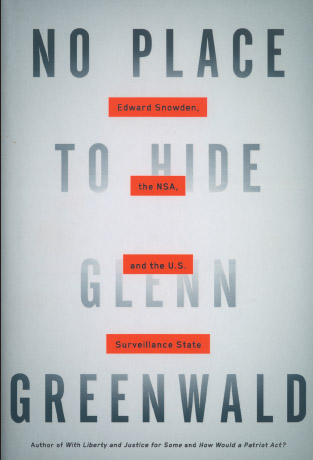
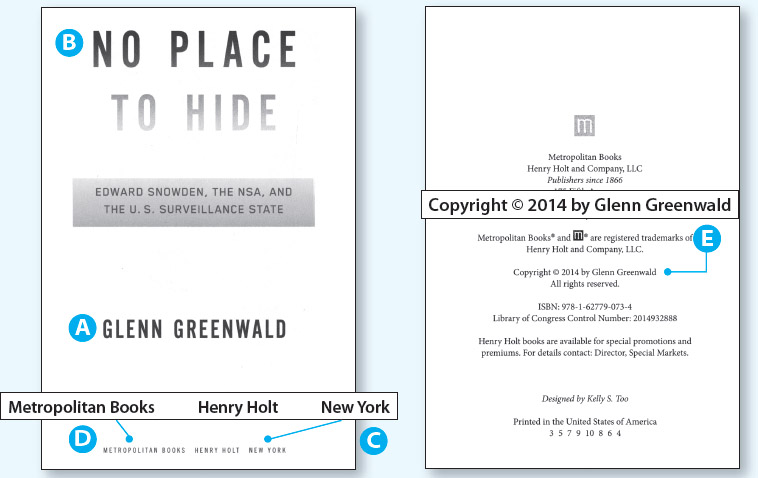
From the book NO PLACE TO HIDE: Edward Snowden, the NSA, and the U.S. Surveillance State. Copyright © 2014 by Glenn Greenwald. Reprinted by permission of Henry Holt and Company, LLC. All rights reserved.
Record the following information:
A The author. Give the last name first, followed by a comma, the first name, and the middle initial (if given). Don’t include titles such as MD, PhD, or Sir; include suffixes after the name, preceded by a comma (Jones, Durham F., Jr.). End with a period.
B The title. Give the full title; include the subtitle (if any), preceded by a colon. Italicize the title and subtitle, capitalizing all major words. End with a period.
C The city of publication. If more than one city is given, use the first one listed. For a city outside the United States that may be unfamiliar to your readers or confused with another city, add the abbreviation for the name of the province (in Canada) or country: London, ON; Plymouth, Eng. Follow this information with a colon.
D The publisher. Give a shortened version of the publisher’s name. If there is an imprint, give the name of the imprint and the publisher, connected with a hyphen. Do not include the word Press, Publisher, or Inc. Insert a comma.
E The date of publication. If more than one copyright date is given, use the most recent one. Use n.d. if no date is given. End with a period.
- F The medium of publication. For a book, this would be Print.

PRINT PERIODICALS
28. Journal Article List the author’s name, the article title (in quotation marks), and the journal title (italicized), followed by the volume number, issue number, year, page number(s), and medium.
Mooney, William. “Sex, Booze, and the Code: Four Versions of the Maltese Falcon.” Literature-Film Quarterly 39.1 (2011): 54–72. Print.
29. Magazine Article List the author’s name, the article title (in quotation marks), and the magazine title (italicized), followed by the issue date, page number(s), and medium.
Seabrook, John. “Crush Point.” New Yorker 7 Feb. 2011: 32–38. Print.
30. Newspaper Article List the author’s name, the article title (in quotation marks), and the newspaper name (italicized), followed by the issue date, page number(s) (which might include a section letter), and medium. If the newspaper appears in more than one edition, add a comma after the date and cite the edition (for example, late ed.). If sections are numbered, add a comma after the date, the word sec., and the section number.
Robertson, Campbell. “Beyond the Oil Spill, the Tragedy of an Ailing Gulf.” New York Times 21 Apr. 2011: A17. Print.
31. Unsigned Article If the author of an article is not indicated, begin with the title. Alphabetize the work by title, ignoring any initial article.
“How Much Is Enough?” Economist 26 Feb. 2011: 5. Print.
32. Article That Skips Pages Give the page on which the article starts, followed by a plus sign (+) and a period.
Kennicott, Philip. “Out-Vermeering Vermeer.” Washington Post 10 Apr. 2011: E1 + Print.
33. Review For a book or film review, give the author of the review and the title of the review (in quotation marks), followed by the words Rev. of and the title of the work reviewed (italicized). Insert a comma and the word by, then give the name of the author of the work reviewed. (Instead of by, you might use ed., trans., or dir., depending on the work.) End with the publication information for the periodical in which the review was published.
Wynne, Clive. “Our Conflicted Relationship with Animals.” Rev. of Some We Love, Some We Hate, Some We Eat, by Hal Herzog. Nature 467.7313 (2010): 275–76. Print.
MLA: CITING AN ARTICLE FROM A PRINT PERIODICAL
Periodicals include journals, magazines, and newspapers. This page gives an example of a citation for an article from a print journal.
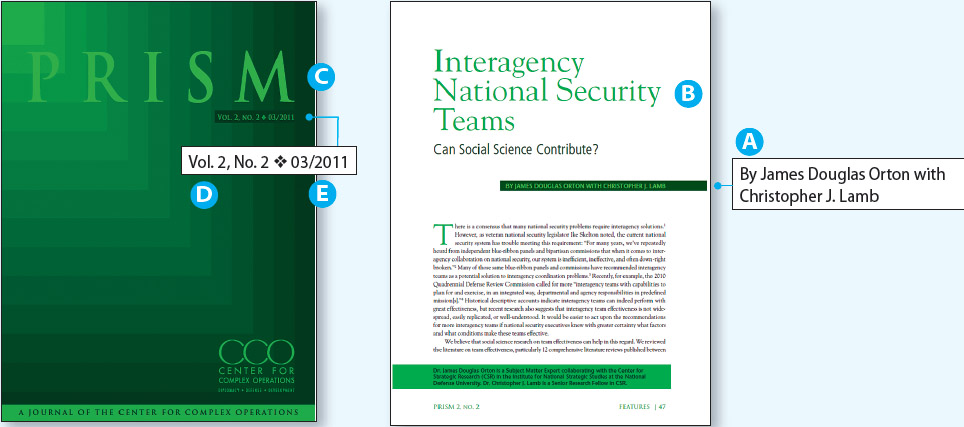
Prism, 2011.
Record the following information:
A The author. Give the last name first, followed by a comma, the first name, and the middle name or initial (if given). Don’t include titles such as MD, PhD, or Sir; include suffixes after the name, preceded by a comma (Jones, Durham F., Jr.). End with a period.
B The article title. Give the full title; include the subtitle (if any), preceded by a colon. Enclose the title in quotation marks, capitalizing all major words. Insert a period inside the closing quotation mark, unless the title includes its own punctuation.
C The periodical title. Italicize the title. Omit any initial article and capitalize all major words.
D The volume number and issue number. For journals, give the volume number, followed by a period (no space) and then the issue number. Give both volume and issue regardless of how the journal is paginated.
E The date of publication. For journals, give the year in parentheses, followed by a colon. For monthly magazines, don’t use parentheses; give the month and year. For weekly magazines and newspapers, don’t use parentheses; give the day, month, and year (in that order). Abbreviate the names of all months except May, June, and July.
F Inclusive page numbers. For a range of page numbers 100 and above, give only the last two digits of the second number if the previous digits are identical (for example, 243–47, not 243–247 or 243–7). Include section letters for newspapers, if relevant. End with a period.
G The medium of publication. Print.

ELECTRONIC SOURCES
34. Entire Website If you are citing an entire website, begin with the name of the author or editor (if given) and the title of the site (italicized). Then give the name of the sponsoring institution or organization (or N.p.), the date of publication or most recent update (or n.d.), the medium, and your access date. Only if necessary, add the URL in angle brackets at the end, followed by a period.
Poets.org. Academy of American Poets, n.d. Web. 12 Jan. 2014.
35. Short Work from a Website If you are citing a portion of a website, begin with the author, the title of the material (in quotation marks), and the title of the site (italicized). Then include the site’s sponsor, the date of publication, the medium, and your access date.
Ferenstein, Greg. “How Mobile Technology Is a Game Changer for Developing Africa.” Mashable. Mashable, 19 July 2010. Web. 14 Jan. 2011.
36. Online Book Begin with the author’s name and the title of the work, along with publication information about the print source. If the book has not been published in print, include the online publication date and publisher. Include the medium. End with your access date.
Martín-Palma, Raúl J., and Akhlesh Lakhtakia. Nanotechnology: A Crash Course. Bellingham: SPIE, 2010. SPIE Digital Library. Web. 16 Jan. 2011.
37. Article in an Online Periodical Begin with the author’s name and include the title of the document, the name of the periodical, and the date of publication. If the periodical is a scholarly journal, include relevant identifying numbers, such as volume, issue, and page numbers (or n. pag. if there are no page numbers). For abstracts of articles, include the word Abstract, followed by a period, after the page number(s). End with the medium and your access date.
Maas, Korey D. “Natural Law, Lutheranism, and the Public Good.” Lutheran Witness 130.3 (2011): n. pag. Web. 14 Jan. 2011.
For magazine and newspaper articles found online, give the author, the title of the article (in quotation marks), the title of the magazine or newspaper (italicized), the sponsor or publisher of the site (use N.p. if there is none), the date of publication, the medium, and your date of access.
Melia, Mike. “Atlantic Garbage Patch: Pacific Gyre Is Not Alone.” Huffington Post. HuffingtonPost.com, 15 Apr. 2010. Web. 13 Feb. 2011.
38. Article from a Database or Subscription Service After giving the print article information, give the name of the database (italicized), the medium (Web), and your access date.
Kunnan, Anthony J. “Publishing in the Era of Online Technologies.” Modern Language Journal 94.4 (2010): 643–45. Academic OneFile. Web. 12 Feb. 2011.
39. Dissertation The title appears in quotation marks if the dissertation is unpublished or in italics if it is published.
Zimmer, Kenyon. The Whole World Is Our Country: Immigration and Anarchism in the United States, 1885–1940. Diss. Pittsburgh: U of Pittsburgh, 2010. Print.
40. CD-ROM Treat material on a CD-ROM as you would if it were in print form. That is, if the source is an article in a database, include CD-ROM after the page numbers, followed by the database title, the vendor, and the publication date of the database. If it is a book, treat it as a book, with CD-ROM as the medium.
Greek-Cypriot Maritime Guide 2011. Alimos, Greece: Marine Information Services, 2011. CD-ROM.
41. Email Message Include the author’s name, the subject line (if any) in quotation marks, and then the words Message to followed by the name of the recipient (if you were the recipient, use the phrase the author). End with the date the email was sent and the medium (E-mail).
Lange, Frauke. “Data for Genealogical Project.” Message to the author. 26 Dec. 2010. E-mail.
42. Online Posting List the author’s name, the subject line (if any) in quotation marks, the name of the discussion group or newsgroup in italics, the sponsor, the posting date, the medium (Web), and your access date. If there is no subject line, use the expression Online posting (not in quotation marks) in its place.
Swallow, Bill. “Re: New Doc Group: FrameMaker or Flare?” TECHWR-L. RayComm, 5 Jan. 2010. Web. 10 Feb. 2011.
43. Other Online Sources Follow the MLA guidelines already discussed, adapting them as appropriate to the electronic medium. The following examples are for a podcast and a blog, respectively. For a podcast, the medium might be Web, MP3 file, MPEG-4 file, Video file, and so on. If the blog doesn’t have a title (in quotation marks), use the expression Web log entry or Web log comment in its place, not in quotation marks.
“Hubble Marks 20 Years of Discovery.” NASACast Video. NASA, 23 Apr. 2010. Web. 15 Jan. 2011.
Raymo, Chet. “Divine Particulars.” Science Musings Blog. Chet Raymo, 21 Jan. 2011. Web. 15 Feb. 2011.
MLA: CITING A SHORT WORK FROM A WEBSITE
You will likely need to search the website to find some of the citation information you need. Always include the sponsor or publisher and the date of publication or most recent update.
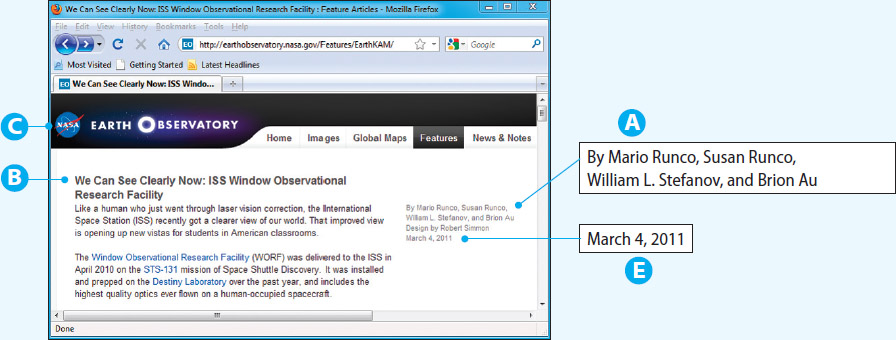
Source: Runco, Runco, Stefanov, and Au, 2011.
Record the following information:
A The author. Give the last name first, followed by a comma, the first name, and the middle initial (if given). Don’t include titles such as MD, PhD, or Sir; include suffixes after the name, preceded by a comma (Jones, Durham F., Jr.). End with a period.
B The document title. Give the full title; include the subtitle (if any), preceded by a colon. Enclose the title in quotation marks, capitalizing all major words. Place a period inside the closing quotation mark, unless the title includes its own punctuation.
C The title of the website. Italicize the title of the website. If there is no clear title and it is a personal home page, use Home page, not italicized. End with a period.
D The name of the sponsoring organization. Look for the sponsor’s name at the bottom of the home page. If you can’t identify the sponsor or publisher, use N.p. End with a comma.
E The date of publication or most recent update. Use the day, month, year format; abbreviate all months except May, June, and July. If you can’t identify the date of publication or most recent update, use n.d. End with a period.
F The medium of publication. Web.
G The retrieval date. Give the most recent date you accessed the site. If there is little likelihood that your reader will be able to find the information using a search engine, give the complete URL, enclosed in angle brackets and followed by a period, after the date. If the URL is very long and complicated, however, give the URL of the site’s search page instead.

MLA: CITING AN ARTICLE FROM A DATABASE
Libraries subscribe to services such as LexisNexis, ProQuest, InfoTrac, and EBSCOhost, which provide access to databases of electronic texts.
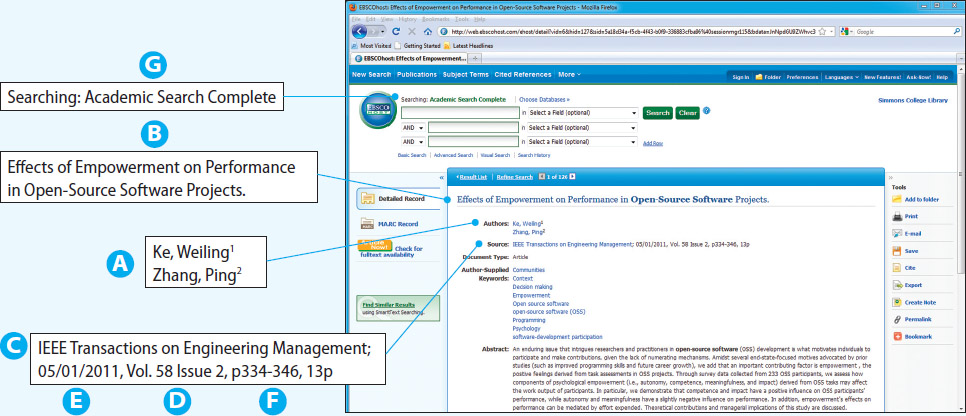
Record the following information:
A The author. Give the last name first, followed by a comma, the first name, and the middle initial (if given). Don’t include titles such as MD, PhD, or Sir; include suffixes after the name, preceded by a comma (Jones, Durham F., Jr.). End with a period.
B The article title. Give the full title; include the subtitle (if any), preceded by a colon. Enclose the title in quotation marks, capitalizing all major words. Place a period inside the closing quotation mark, unless the title includes its own punctuation.
C The periodical title. Italicize the title. Omit any initial article, and capitalize all major words.
D The volume number and issue number (if appropriate).
E The date of publication. For journals, give the year in parentheses. For monthly magazines, don’t use parentheses; give the month and year. For weekly magazines and newspapers, don’t use parentheses; give the day, month, and year (in that order).
F Inclusive page numbers. If only the first page number is given, follow it with a plus sign and a period.
G The name of the database. Italicize the name.
H The medium of publication. Web.
I The retrieval date. Use the day, month, year format. If necessary, add the URL, enclosed in angle brackets and followed by a period.

OTHER SOURCES
44. Government Document For a government publication, begin with the name of the country and the government agency. Follow with the document title. Then give the name of the author (if known), preceded by the word By. Follow with the report number or identifying number (if any), the location and name of the publisher, the date, and the medium.
United States. National Commission on the Causes of the Financial and Economic Crisis. The Financial Crisis Inquiry Report: Final Report of the National Commission on the Causes of the Financial and Economic Crisis in the United States. Washington: GPO, 2011. Print.
For an online source, follow the report number with the publisher or sponsor, the date of publication, the medium, and your date of access.
United States. Dept. of the Interior. A Refined Characterization of the Alluvial Geology of Yucca Flat and Its Effect on Bulk Hydraulic Conductivity. By G. A. Phelps, A. Boucher, and K. J. Halford. Open-File Report 2010-1307. US Geological Survey, 2011. Web. 12 Feb. 2011.
45. Article from Conference Proceedings List the author’s name, the article title, the proceedings title, and the editor’s name, followed by the publication information and the medium.
Glicksman, Robert. “Climate Change Adaptation and the Federal Lands.” The Past, Present, and Future of Our Public Lands: Celebrating the 40th Anniversary of the Public Land Law Review Commission’s Report. Ed. Gary C. Bryner. Boulder: Natural Resources Law Center, 2010. Print.
46. Pamphlet Cite a pamphlet as you would a book.
US Geological Survey. Facing Tomorrow’s Challenges: An Overview. Denver: Habitat, 2008. Print.
47. Report Cite a report as you would a book.
Liebreich, Michael, et al. Green Investing 2010: Policy Mechanisms to Bridge the Financing Gap. Geneva: World Economic Forum, 2010. Print.
48. Interview For a published interview, begin with the name of the person interviewed. If the interview has a title, enclose it in quotation marks. Insert the word Interview and give the interviewer’s name, if relevant, followed by a period and the information on the work in which the interview was published.
Walcott, Derek. “Purple Prose.” Interview by Alexander Newbauer. Harper’s Magazine Feb. 2010: 24–26. Print.
If you conducted the interview yourself, give the interviewee’s name, the words Personal interview, and the date.
Youngblood, Adelaide. Personal interview. 5 Jan. 2011.
49. Letter or Memo If the letter or memo was addressed to you, give the writer’s name, the words Letter [or Memo] to the author, and the date it was written. End with the medium (e.g., MS for manuscript or TS for typescript).
Jakobiak, Ursula. Letter to the author. 27 Oct. 2010. MS.
If the letter or memo was addressed to someone other than you, give the recipient’s name in place of the words the author.
50. Lecture or Speech Give the speaker’s name, the title of the lecture or speech (if known), the event and sponsoring organization (if applicable), and the place and date. End with the medium (such as Lecture or Keynote Speech).
Wang, Samuel. “Neuroscience and Everyday Life.” Freshman Assembly, Princeton University, Princeton, NJ. 12 Sept. 2010. Lecture.
51. Map or Chart Give the author (if known), the title (in quotation marks), the word Map or Chart, the publication information, and the medium. For an online source, follow the word Map or Chart with the name of the website (italicized), the name of the site’s sponsor or publisher, the date of publication, the medium, and the date of access.
“Aftershock Map Tohoku Earthquake.” Map. Earthquake Hazards Program. US Geological Survey, 11 Mar. 2011. Web. 14 Apr. 2011.
52. Photograph or Work of Art Give the name of the artist; the title of the artwork, italicized; the date of composition; the medium of composition; and the institution and city in which the artwork can be found. For artworks found online, omit the medium of composition and include the sponsor and the title of the website on which you found the work, the medium, and your date of access.
Smedley, W. T. On the Beach at Narragansett Pier. 1900. Prints and Photographs Div., Lib. of Cong. Cabinet of American Illustration. Web. 15 Feb. 2011.
53. Legal Source For a legal case, give the name of the first plaintiff and first defendant, the law report number, the name of the court, the year of the decision, publication information, the medium, and the date of access (if on the web).
Natl. Assn. of Home Builders v. Defenders of Wildlife. No. 06-340. Supreme Court of the US. 2007. Supreme Court of the United States. Web. 12 Feb. 2011.
For a legislative act, give the name of the act, the Public Law number, the Statutes at Large volume and page numbers, the date the law was enacted, the medium, and the date of access.
Protect America Act of 2007. Pub. L. 110-55. 5 Stat. 121–552. 5 Aug. 2007. Web. 15 Feb. 2011.
54. Radio or Television Program Give the title of the episode or segment, if applicable, and the title of the program. Include relevant information about the host, writer, director, or performers. Then give the network, call letters and city for the local station (if any), the broadcast date, and the medium. If you accessed the program on the web, instead of the original medium, give the title of the website, the medium (Web), and your date of access.
“Aircraft Safety.” Nightline. Narr. Cynthia McFadden. ABC. WCVB, Boston, 4 Apr. 2011. Television.
“Petty Tyrant.” This American Life. Host Ira Glass. Natl. Public Radio. WBEZ, Chicago, 12 Nov. 2010. Radio.
55. Film, Video, or DVD Give the title of the film and the name of the director. You may also give the names of major performers (Perf.) or the narrator (Narr.). Give the distributor, the year of the original release, and the medium (Film, DVD, or Videocassette).
The King’s Speech. Dir. Tom Hooper. Perf. Colin Firth, Geoffrey Rush, and Helena Bonham Carter. The Weinstein Co., 2010. Film.
56. Advertisement Include the name of the product, organization, or service being advertised; the word Advertisement; and the publication information. If you accessed the advertisement online, give your access date after the medium (Web).
NeutronicEar. Advertisement. Smithsonian Mar. 2011: 89. Print.
Following is a sample list of works cited using the MLA citation system.
Book in an edition other than the first
Article from a database
Chapter in an edited book
Article in an online newspaper
Journal article
